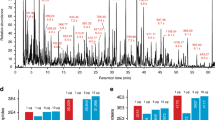Abstract
Efforts to develop a liquid chromatography (LC)/mass spectrometry (MS) technology for ultra-sensitive proteomics studies (i.e., nanoscale proteomics) are described. The approach combines high-efficiency nanoscale LC (separation peak capacity of ≈103; 15-μm-i.d. packed capillaries with flow rates of 20 nL min−1, the optimal separation linear velocity) with advanced MS, including high-sensitivity and high-resolution Fourier transform ion cyclotron resonance MS, to perform both single-stage MS and tandem MS (MS/MS) proteomic analyses. The technology enables broad protein identification from nanogram-size proteomics samples and allows the characterization of more abundant proteins from sub-picogram-size samples. Protein identification in such studies using MS is demonstrated from <75 zeptomole of a protein. The average proteome measurement throughput is ~50 proteins h−1 using MS/MS during separations, presently requiring approximately 3 h sample−1. Greater throughput (~300 proteins h−1) and improved detection limits providing more comprehensive proteome coverage can be obtained by using the “accurate mass and time” tag approach developed in our laboratory. This approach provides a dynamic range of at least 106 for protein relative abundances and an improved basis for quantitation. These capabilities lay the foundation for studies from single or limited numbers of cells.






Similar content being viewed by others
References
Devine KM, Wolfe K (1995) Trends Genet 11:429; http://www.ebi.ac.uk/research/cgg/genomes.html; http://www.tigr.org
Pandey A, Mann M (2000) Nature 405:837
Heppner GH, Miller FR (1998) Int Rev Cytol 177:1
Emmert-Buck MR et al (1996) Science 274:998; Bonner RF et al (1997) Science 278:1481
Sgroi DC et al (1999) Cancer Res 59:5656; Roth MJ et al (2001) Cancer Res 61:4098
Shen Y et al (2001) Anal Chem 73:1766; 3011
Washburn MP et al (2001) Nat Biotechnol 19:242; Wolters DA et al (2001) Anal Chem 73:5683
Fann JB et al (1989) Science 246:64
Marshall AG et al (1998) Mass Spectrom Rev 17:1; Martin SE et al (2000) Anal Chem 72:4266; Quenzer EL et al (2001) Anal Chem 73:1721; Belov et al (2003) Anal Chem 75:4195
Anderson GA et al (1998) Proceedings of the 46th ASMS conference on mass spectrometry and allied topics, p 1270; Bruce JE et al (1999) Anal Chem 71:2595; Goodlett DR et al (2000) Anal Chem 72:1112; Harkewicz R et al (2002) J Am Soc Mass Spectrom 13:144
Bruins AP, Covey TR, Henion JD (1987) Anal Chem 59:2642
Shen Y et al (2002) Anal Chem 74:4235
Martin SE, Shabanowitz J, Hunt DF, Marto JA (2000) Anal Chem 72:4266
Quenzer TL et al (2001) Anal Chem 73:1721
Haskins WE et al (2001) Anal Chem 73:5005
Chen J et al (2003) Anal Chem 75:3145
Shen Y et al (2003) Anal Chem 75:3596
Shen Y et al (2003) Anal Chem (in press)
Anderson GA, Bruce JE (eds) (1995) ICR-2LS, Tolić N (ed) (2001) LaV2DG. Pacific Northwest National Laboratory, Richland, WA
ftp://ftp.tigr.org/pub/data/d_radiodurans/GDR.pep. Cited 31 July 2003
Lipton MS et al (2002) Proc Natl Acad Sci USA 99:11049
Shen Y et al (2003) Anal Chem (submitted)
Masselon CD et al (2000) Anal Chem 72:1918
Li L et al (2001) Anal Chem 73:3312
Oda Y et al (1999) Proc Natl Acad Sci USA 96:6591
Acknowledgments
We thank the US Department of Energy’s Office of Biological and Environmental Research and the National Cancer Institute (Grant CA 86340) for their support of portions of this research. Pacific Northwest National Laboratory is operated by the Battelle Memorial Institute for the US Department of Energy through Contract DE-ACO6–76RLO 1830.
Author information
Authors and Affiliations
Corresponding author
Rights and permissions
About this article
Cite this article
Shen, Y., Tolić, N., Masselon, C. et al. Nanoscale proteomics. Anal Bioanal Chem 378, 1037–1045 (2004). https://doi.org/10.1007/s00216-003-2329-8
Received:
Revised:
Accepted:
Published:
Issue Date:
DOI: https://doi.org/10.1007/s00216-003-2329-8




